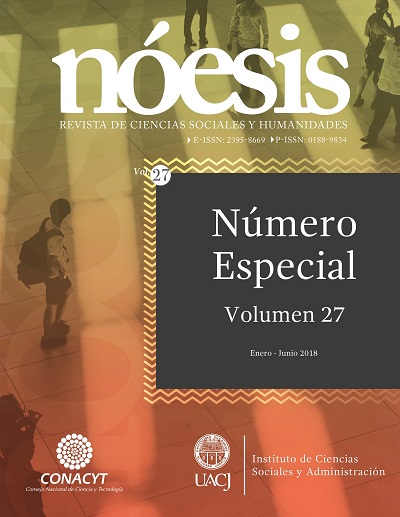Organizational responsiveness and absorptive capacity. Study of manufacturing companies in Mexico
Main Article Content
Abstract
Absorptive capacity is the mechanism for companies to acquire, assimilate and exploit new knowledge from abroad and respond assertively. Strategic orientation is perceived when that knowledge is expanded to create the desired results. The purpose is to analyze the relationship between absorptive capacity and organizational responsiveness, as well as to demonstrate the moderation of strategic orientation in this relationship. The results show that the dimensions of the absorption capacity: acquisition, assimilation and exploitation of external knowledge as well as strategic orientation are positive predictors of organizational response capacity. Using a hierarchical regression model, it is identified that the strategic orientation neither amplifies nor attenuates the relationship between absorption capacity and response capacity. The response capacity is expected to increase when organizations develop absorption capacity and strategic orientation.
Downloads
Article Details

This work is licensed under a Creative Commons Attribution-NonCommercial-ShareAlike 4.0 International License.
References
Barkema, Harry y Ana Nadolska. 2003. How internationalizing firms develop their absorptive capacity over time: The case of acquisitions. Academy of Management Proceedings.
Becker, Wolfgang y Jüngen Peters. 2000. Technological opportunities, absorptive capacities and innovation. The Eighth International Joseph A. Schumpeter Society Conference. Manchester.
Camisón, César y Beatriz Forés. 2010. Knowledge absorptive capacity. New insights for its conceptualization and measurement. Journal of Business Research, 63: 707-715. DOI: https://doi.org/10.1016/j.jbusres.2009.04.022
Chauvet, Vincent. 2014. Absorptive capacity: Scale development and implications for future research. Management International, 19(1):113-129. DOI: https://doi.org/10.7202/1028493ar
Choo, Chun 1996. The knowing organization: How organizations use information to construct meaning, create knowledge, and make decisions. International journal of Information Management, 16, (5): 329-340. DOI: https://doi.org/10.1016/0268-4012(96)00020-5
Cohen, Wesley y Daniel Levinthal. 1990. Absorptive capacity: A new perspective on learning and innovation. Administrative Sciences Quarterly, 35 (1): 128-152. DOI: https://doi.org/10.1016/B978-0-7506-7223-8.50005-8
Cohen, Wesley y Daniel Levinthal. 1994. Fortune favors the prepared firm. Management Science, 40:227-251. DOI: https://doi.org/10.1287/mnsc.40.2.227
Fernhaber, Stephanie y Pankaj Patel. 2012. How do young firms manage product portfolio complexity? The role of absorptive capacity and ambidexterity. Strategic Management Journal, 33 (13): 1516-1539. DOI: https://doi.org/10.1002/smj.1994
Flor, María, María Oltra y Cristina García. 2011. La relación entre la capacidad de absorción del conocimiento externo y la estrategia empresarial: Un análisis exploratorio. Revista Europea de Dirección y Economía de la Empresa, 20, (1): 69-88.
Hair, Joseph, Anderson Rolph, Tatham Ronald y Black William. 1999. Análisis multivariante. Madrid: Prentice Hall.
Hakala, Henri. 2010. Configuring out strategic orientation. Business administration 95, management and organization. Finlandia: University of Vassa.
Herat, H. y Mahmood Rosli. 2014. Strategic orientation and SME performance: moderating effect of absorptive capacity of the firm. Asian Social Science, 10 (13): 95-107. DOI: http://dx.doi.org/10.5539/ass.v10n13p95
Huber, George. 1991. Organizational learning: The contributing processes and the literatures. Organization Science, 2(1): 88–115. DOI: https://doi.org/10.1287/orsc.2.1.88
DOF. 2009. Diario Oficial de la Federación. Acuerdo por el que se establece la estratificación de las micro, pequeñas y medianas empresas. http://dof.gob.mx/nota_detalle.php?codigo=5096849&fecha=30/06/2009 (24 de marzo del 2017).
INEGI. 2015. Censos económicos 2014. (15 de enero de 2018).
Jansen, Justin, Frans Van Den Bosch y Henk Volverda. 2005. Managing potential and realized absorptive capacity: How do organizational antecedents matter?. Academy of Management Journal, 48(6): 999-1015. DOI: https://doi.org/10.5465/AMJ.2005.19573106
Kohli, Ajay y Bernard Jaworski. 1990. Market orientation. The construct, research propositions and managerial implications. Journal of Marketing, 54: 1-18. DOI: https://doi.org/10.2307/1251866
Lane, Peter y Michael Lubatkin. 1998. Relative absorptive capacity and inter organizational learning. Strategic Management Journal, 19: 461-477. DOI: https://doi.org/10.1002/(SICI)1097-0266(199805)19:5<461::AID-SMJ953>3.0.CO;2-L
Lane, Peter, Balaji Koka y Seemantini Pathatk. 2006. The reification of absorptive capacity: A critical review and rejuvenation of the construct. Academic of Management Review, 31: 833-863. DOI: https://doi.org/10.5465/AMR.2006.22527456
Lenox, Michael y Andrew King. 2004. Prospects for developing absorptive capacity through internal information provision. Strategic Management Journal, 25: 331-345. DOI: https://doi.org/10.1002/smj.379
Liao, Jianwen, Harold Welsch y Michael Stoica. 2003. Organizational absorptive capacity and responsiveness: An empirical investigation of growth-oriented SMEs. Entrepreneurship: Theory & Practice, 28(1): 63-85. DOI: https://doi.org/10.1111/1540-8520.00032
Miles, Raymond y Charles Snow. 2003. Organizational strategy, structure and process. Nueva York: McGraw-Hill.
Minbaeva, D., T. Pedersen, I. Björkman, C. Fey y J. Park. 2003. MNC knowledge transfer, subsidiary absorptive capacity and HRM. Journal of International Business Studies, 34: 586-599. DOI: https://doi.org/10.1057/palgrave.jibs.8400056
Morales, Pedro. 2013. El análisis factorial en la construcción e interpretación de tests, escalas y cuestionarios. Madrid: Universidad Pontificia Comillas.
Newey, Lance y Arthur Shulman. 2004. Systemic absorptive capacity: Creating early-to-market returns through R&D alliances. R&D Management, 34: 495-504. DOI: https://doi.org/10.1111/j.1467-9310.2004.00357.x
Nieto, Mariano y Pilar Quevedo. 2005. Absorptive capacity, technological opportunity, knowledge spillovers, and innovative effort. Technovation, 25: 1141-1157. DOI: https://doi.org/10.1016/j.technovation.2004.05.001
Nonaka, Ikujiro y HirotakaTakeuchi. 1995. The knowledge- creating company: How japanese companies create the dynamics of innovation. Nueva York-Oxford Oxford: University Press.
Nunnally, Jum y Ira Bernstein. 1994. Psychometric theory. Nueva York: McGraw-Hill.
Stock, G., N. Greis y W. Fischer 2001. Absorptive capacity and new product development. Journal of High Technology Management Research, 12(1): 77-92. DOI: https://doi.org/10.1016/S1047-8310(00)00040-7
Van Den Bosch, Frans, Henrik Volberda y Michiel De Boer. 1999. Coevolution of firm absorptive capacity and knowledge enviroment: Organizational forms and combinative capabilities. Organization Science, 10: 551-568. DOI: https://doi.org/10.1287/orsc.10.5.551
Volberda, Henrik, Nicola Juul y Marjorie Lyles. 2010. Absorbing the concept of absorptive capacity: How to realize its potential in the organization field. Organization Science, 21 (4): 931-951. DOI: https://doi.org/10.1287/orsc.1090.0503
Weick, Karl. 1979. The social psychology of organizing. Nueva York: McGraw-Hill.
Zahra, Shaker y Gerald George. 2002. Absorptive capacity: A review and reconceptualization. Academy of Management Review, 27: 185-203.

